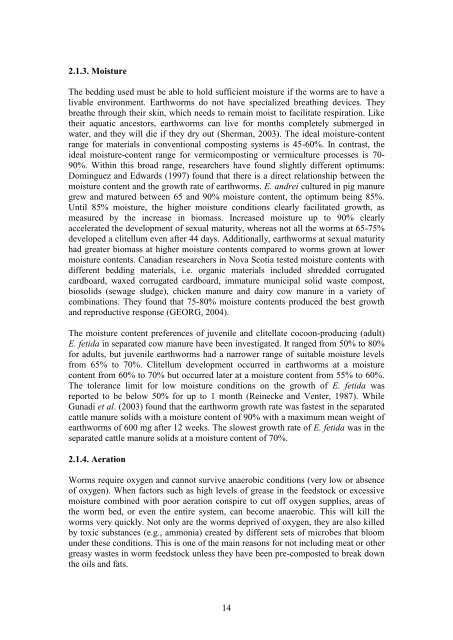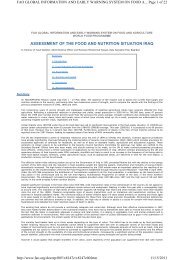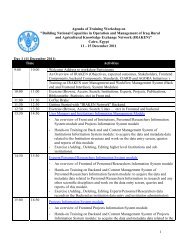Vermiculture in Egypt: - FAO - Regional Office for the Near East and
Vermiculture in Egypt: - FAO - Regional Office for the Near East and
Vermiculture in Egypt: - FAO - Regional Office for the Near East and
Create successful ePaper yourself
Turn your PDF publications into a flip-book with our unique Google optimized e-Paper software.
2.1.3. Moisture<br />
The bedd<strong>in</strong>g used must be able to hold sufficient moisture if <strong>the</strong> worms are to have a<br />
livable environment. Earthworms do not have specialized breath<strong>in</strong>g devices. They<br />
brea<strong>the</strong> through <strong>the</strong>ir sk<strong>in</strong>, which needs to rema<strong>in</strong> moist to facilitate respiration. Like<br />
<strong>the</strong>ir aquatic ancestors, earthworms can live <strong>for</strong> months completely submerged <strong>in</strong><br />
water, <strong>and</strong> <strong>the</strong>y will die if <strong>the</strong>y dry out (Sherman, 2003). The ideal moisture-content<br />
range <strong>for</strong> materials <strong>in</strong> conventional compost<strong>in</strong>g systems is 45-60%. In contrast, <strong>the</strong><br />
ideal moisture-content range <strong>for</strong> vermicompost<strong>in</strong>g or vermiculture processes is 70-<br />
90%. With<strong>in</strong> this broad range, researchers have found slightly different optimums:<br />
Dom<strong>in</strong>guez <strong>and</strong> Edwards (1997) found that <strong>the</strong>re is a direct relationship between <strong>the</strong><br />
moisture content <strong>and</strong> <strong>the</strong> growth rate of earthworms. E. <strong>and</strong>rei cultured <strong>in</strong> pig manure<br />
grew <strong>and</strong> matured between 65 <strong>and</strong> 90% moisture content, <strong>the</strong> optimum be<strong>in</strong>g 85%.<br />
Until 85% moisture, <strong>the</strong> higher moisture conditions clearly facilitated growth, as<br />
measured by <strong>the</strong> <strong>in</strong>crease <strong>in</strong> biomass. Increased moisture up to 90% clearly<br />
accelerated <strong>the</strong> development of sexual maturity, whereas not all <strong>the</strong> worms at 65-75%<br />
developed a clitellum even after 44 days. Additionally, earthworms at sexual maturity<br />
had greater biomass at higher moisture contents compared to worms grown at lower<br />
moisture contents. Canadian researchers <strong>in</strong> Nova Scotia tested moisture contents with<br />
different bedd<strong>in</strong>g materials, i.e. organic materials <strong>in</strong>cluded shredded corrugated<br />
cardboard, waxed corrugated cardboard, immature municipal solid waste compost,<br />
biosolids (sewage sludge), chicken manure <strong>and</strong> dairy cow manure <strong>in</strong> a variety of<br />
comb<strong>in</strong>ations. They found that 75-80% moisture contents produced <strong>the</strong> best growth<br />
<strong>and</strong> reproductive response (GEORG, 2004).<br />
The moisture content preferences of juvenile <strong>and</strong> clitellate cocoon-produc<strong>in</strong>g (adult)<br />
E. fetida <strong>in</strong> separated cow manure have been <strong>in</strong>vestigated. It ranged from 50% to 80%<br />
<strong>for</strong> adults, but juvenile earthworms had a narrower range of suitable moisture levels<br />
from 65% to 70%. Clitellum development occurred <strong>in</strong> earthworms at a moisture<br />
content from 60% to 70% but occurred later at a moisture content from 55% to 60%.<br />
The tolerance limit <strong>for</strong> low moisture conditions on <strong>the</strong> growth of E. fetida was<br />
reported to be below 50% <strong>for</strong> up to 1 month (Re<strong>in</strong>ecke <strong>and</strong> Venter, 1987). While<br />
Gunadi et al. (2003) found that <strong>the</strong> earthworm growth rate was fastest <strong>in</strong> <strong>the</strong> separated<br />
cattle manure solids with a moisture content of 90% with a maximum mean weight of<br />
earthworms of 600 mg after 12 weeks. The slowest growth rate of E. fetida was <strong>in</strong> <strong>the</strong><br />
separated cattle manure solids at a moisture content of 70%.<br />
2.1.4. Aeration<br />
Worms require oxygen <strong>and</strong> cannot survive anaerobic conditions (very low or absence<br />
of oxygen). When factors such as high levels of grease <strong>in</strong> <strong>the</strong> feedstock or excessive<br />
moisture comb<strong>in</strong>ed with poor aeration conspire to cut off oxygen supplies, areas of<br />
<strong>the</strong> worm bed, or even <strong>the</strong> entire system, can become anaerobic. This will kill <strong>the</strong><br />
worms very quickly. Not only are <strong>the</strong> worms deprived of oxygen, <strong>the</strong>y are also killed<br />
by toxic substances (e.g., ammonia) created by different sets of microbes that bloom<br />
under <strong>the</strong>se conditions. This is one of <strong>the</strong> ma<strong>in</strong> reasons <strong>for</strong> not <strong>in</strong>clud<strong>in</strong>g meat or o<strong>the</strong>r<br />
greasy wastes <strong>in</strong> worm feedstock unless <strong>the</strong>y have been pre-composted to break down<br />
<strong>the</strong> oils <strong>and</strong> fats.<br />
14





